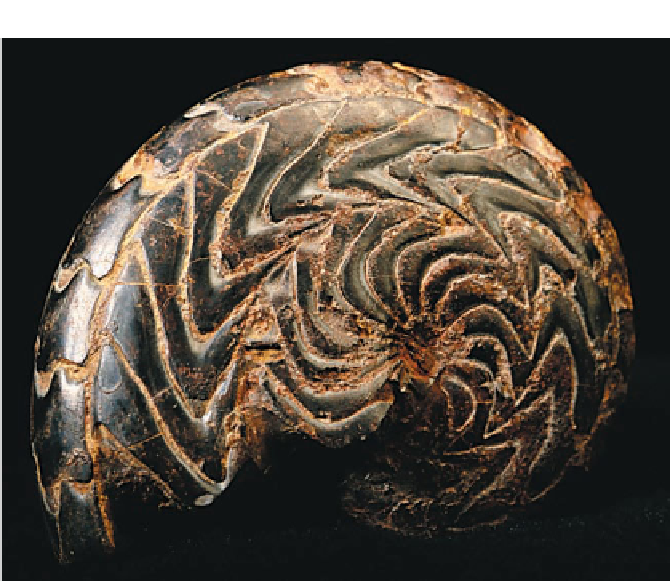Geology Reference
In-Depth Information
majority of Mississippian sedimentary
rocks.
The Permian invertebrate marine
faunas resembled those of the Carbonifer-
ous, but were not as widely distributed be-
cause of the restricted size of the shallow
seas on the cratons and the reduced shelf
space along the continental margins (see
Figure 20.20). The spiny and odd-shaped
productids dominated the brachiopod as-
semblage and constituted an important
part of the reef complexes that formed
in the Texas region during the Permian
(
Figure 21.12). The fusulinids (spindle-
shaped foraminifera), which fi rst evolved
during the Late Mississippian and greatly
diversified during the Pennsylvanian,
experienced a further diversification
during the Permian. Because of their
abundance, diversity, and worldwide oc-
currence, fusulinids are important guide
fossils for the Pennsylvanian and Perm-
ian strata. Bryozoans, sponges, and some
types of calcareous algae also were com-
mon elements of the Permian inverte-
brate fauna.
◗
◗
Figure 21.10
Ammonoid Cephalopod A Late Devonian-age ammonoid cephalopod
from Erfoud, Morocco. The distinctive suture pattern, short stratigraphic range, and wide
geographic distribution make ammonoids excellent guide fossils.
those existing earlier in the Paleozoic virtually disappeared
and were replaced by small patch reefs. These reefs were
dominated by crinoids, blastoids, lacy bryozoans, brachio-
pods, and calcareous algae and fl ourished during the Late
Paleozoic (
Mass Extinction
The greatest recorded mass extinction to affect Earth
occurred at the end of the Permian Period (
Figure 21.11). In addition, broyozoans and cri-
noids contributed large amounts of skeletal debris to the
formation of the vast bedded limestones that constitute the
◗
Figure 21.13).
Before the Permian ended, roughly 50% of all marine in-
vertebrate families and about
90% of all marine invertebrate
species became extinct. Fu-
sulinids, rugose and tabulate
corals, and several bryozoan
and brachiopod orders, as
well as trilobites and blastoids,
did not survive the end of the
Permian. All of these groups
had been very successful dur-
ing the Paleozoic Era. In ad-
dition, more than 65% of all
amphibians and reptiles, as
well as nearly 33% of insects
on land, became extinct.
What caused such a cri-
sis for both marine and land-
dwelling organisms? Various
hypotheses have been pro-
posed, but no completely sat-
isfactory answer has yet been
found. Because the extinction
event extended over many mil-
lions of years at the end of the
◗
Image not available due to copyright restrictions


Search WWH ::

Custom Search